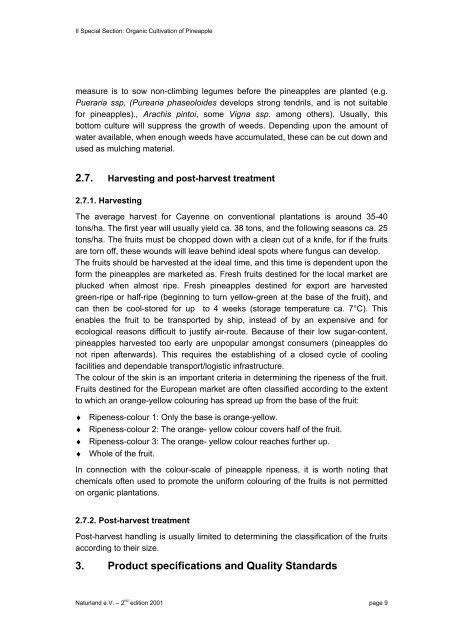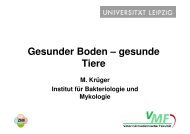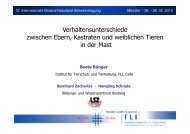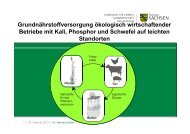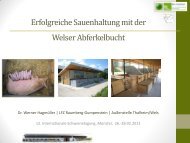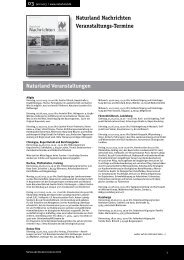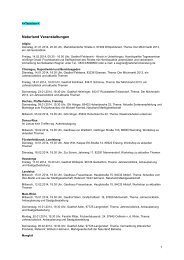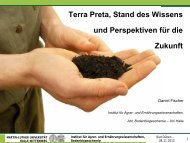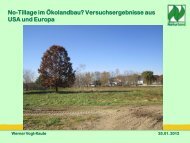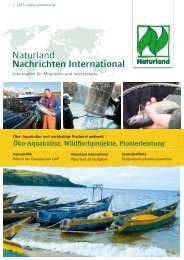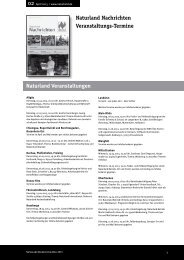Organic Farming in the Tropics and Subtropics: Pineapple - Naturland
Organic Farming in the Tropics and Subtropics: Pineapple - Naturland
Organic Farming in the Tropics and Subtropics: Pineapple - Naturland
You also want an ePaper? Increase the reach of your titles
YUMPU automatically turns print PDFs into web optimized ePapers that Google loves.
II Special Section: <strong>Organic</strong> Cultivation of P<strong>in</strong>eapple<br />
measure is to sow non-climb<strong>in</strong>g legumes before <strong>the</strong> p<strong>in</strong>eapples are planted (e.g.<br />
Pueraria ssp, (Purearia phaseoloides develops strong tendrils, <strong>and</strong> is not suitable<br />
for p<strong>in</strong>eapples)., Arachis p<strong>in</strong>toi, some Vigna ssp. among o<strong>the</strong>rs). Usually, this<br />
bottom culture will suppress <strong>the</strong> growth of weeds. Depend<strong>in</strong>g upon <strong>the</strong> amount of<br />
water available, when enough weeds have accumulated, <strong>the</strong>se can be cut down <strong>and</strong><br />
used as mulch<strong>in</strong>g material.<br />
2.7. Harvest<strong>in</strong>g <strong>and</strong> post-harvest treatment<br />
2.7.1. Harvest<strong>in</strong>g<br />
The average harvest for Cayenne on conventional plantations is around 35-40<br />
tons/ha. The first year will usually yield ca. 38 tons, <strong>and</strong> <strong>the</strong> follow<strong>in</strong>g seasons ca. 25<br />
tons/ha. The fruits must be chopped down with a clean cut of a knife, for if <strong>the</strong> fruits<br />
are torn off, <strong>the</strong>se wounds will leave beh<strong>in</strong>d ideal spots where fungus can develop.<br />
The fruits should be harvested at <strong>the</strong> ideal time, <strong>and</strong> this time is dependent upon <strong>the</strong><br />
form <strong>the</strong> p<strong>in</strong>eapples are marketed as. Fresh fruits dest<strong>in</strong>ed for <strong>the</strong> local market are<br />
plucked when almost ripe. Fresh p<strong>in</strong>eapples dest<strong>in</strong>ed for export are harvested<br />
green-ripe or half-ripe (beg<strong>in</strong>n<strong>in</strong>g to turn yellow-green at <strong>the</strong> base of <strong>the</strong> fruit), <strong>and</strong><br />
can <strong>the</strong>n be cool-stored for up to 4 weeks (storage temperature ca. 7°C). This<br />
enables <strong>the</strong> fruit to be transported by ship, <strong>in</strong>stead of by an expensive <strong>and</strong> for<br />
ecological reasons difficult to justify air-route. Because of <strong>the</strong>ir low sugar-content,<br />
p<strong>in</strong>eapples harvested too early are unpopular amongst consumers (p<strong>in</strong>eapples do<br />
not ripen afterwards). This requires <strong>the</strong> establish<strong>in</strong>g of a closed cycle of cool<strong>in</strong>g<br />
facilities <strong>and</strong> dependable transport/logistic <strong>in</strong>frastructure.<br />
The colour of <strong>the</strong> sk<strong>in</strong> is an important criteria <strong>in</strong> determ<strong>in</strong><strong>in</strong>g <strong>the</strong> ripeness of <strong>the</strong> fruit.<br />
Fruits dest<strong>in</strong>ed for <strong>the</strong> European market are often classified accord<strong>in</strong>g to <strong>the</strong> extent<br />
to which an orange-yellow colour<strong>in</strong>g has spread up from <strong>the</strong> base of <strong>the</strong> fruit:<br />
♦ Ripeness-colour 1: Only <strong>the</strong> base is orange-yellow.<br />
♦ Ripeness-colour 2: The orange- yellow colour covers half of <strong>the</strong> fruit.<br />
♦ Ripeness-colour 3: The orange- yellow colour reaches fur<strong>the</strong>r up.<br />
♦ Whole of <strong>the</strong> fruit.<br />
In connection with <strong>the</strong> colour-scale of p<strong>in</strong>eapple ripeness, it is worth not<strong>in</strong>g that<br />
chemicals often used to promote <strong>the</strong> uniform colour<strong>in</strong>g of <strong>the</strong> fruits is not permitted<br />
on organic plantations.<br />
2.7.2. Post-harvest treatment<br />
Post-harvest h<strong>and</strong>l<strong>in</strong>g is usually limited to determ<strong>in</strong><strong>in</strong>g <strong>the</strong> classification of <strong>the</strong> fruits<br />
accord<strong>in</strong>g to <strong>the</strong>ir size.<br />
3. Product specifications <strong>and</strong> Quality St<strong>and</strong>ards<br />
Naturl<strong>and</strong> e.V. – 2 nd edition 2001 page 9


